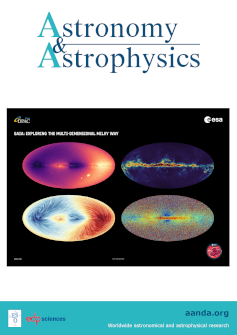Implications of a turbulent convection model for classical Cepheids
IF 5.8
2区 物理与天体物理
Q1 ASTRONOMY & ASTROPHYSICS
引用次数: 0
Abstract
Context. The appearance of blue loops in the evolutionary tracks of intermediate-mass core He-burning stars is essential for explaining the observed characteristics of Cepheïds. The blue loops for lower mass Cepheïds cannot always be reproduced when only classical, local mixing length theory (MLT) is used. Additionally, classical models result in a mass discrepancy compared to pulsational and dynamical mass determinations. Both problems can be resolved through an ad hoc extension of the MLT for convection.Aims. We use the nonlocal Kuhfuss turbulent convection model (TCM), which allows us to explain the overshooting directly by solving the TCM equations. The primary objective of this study is to test the predictions of the Kuhfuss TCM when applied to intermediate-mass core He-burning stars and validate the model predictions against observations of Cepheïds.Methods. We used the state-of-the-art 1D stellar evolution code GARSTEC with the implementation of the Kuhfuss TCM and computed evolutionary tracks for intermediate-mass core He-burning stars. We compared these tracks with those computed with MLT, including and excluding ad hoc overshooting and with observations of five Cepheïds in detached binary systems obtained from the literature.Results. The stellar evolution tracks generated using the Kuhfuss TCM and MLT with ad hoc overshooting exhibit similar appearances. Overshoot mixing from the convective boundaries and the occurrence of the Cepheïd blue-loop have been achieved naturally as solutions to the equations of the Kuhfuss TCM. Furthermore, the evolutionary models, including the Kuhfuss TCM, have been successful in reproducing the observed stellar parameters, including mass, luminosity, radius, and effective temperature.Conlcusions. We successfully generated Cepheïds’ blue loops with a TCM without any fine-tuning of the involved numerical parameters and with overshooting predicted directly from the convection theory. Beyond the achievement of blue loops, our approach which treats convection more physically has also been able to reproduce the observations of Cepheïds in eclipsing binary systems, with a similar level of accuracy as MLT models with ad hoc overshooting.经典造父变星湍流对流模型的意义
上下文。在中等质量核氦燃烧恒星的演化轨迹中出现的蓝色环对于解释观测到的Cepheïds的特征是必不可少的。当仅使用经典的局部混合长度理论(MLT)时,较低质量Cepheïds的蓝色环并不总是能够再现。此外,与脉动和动力质量测定相比,经典模型导致质量差异。这两个问题都可以通过对MLT的特别扩展来解决。我们使用非局部Kuhfuss湍流对流模型(TCM),该模型允许我们通过求解TCM方程直接解释超调。本研究的主要目的是测试Kuhfuss TCM在应用于中质量核心he燃烧恒星时的预测,并根据Cepheïds.Methods的观测验证模型预测。我们使用了最先进的1D恒星演化代码GARSTEC,实现了Kuhfuss TCM,并计算了中等质量核心he燃烧恒星的演化轨迹。我们将这些轨迹与MLT计算的轨迹进行了比较,包括和排除了临时超调,并与从文献中获得的分离双星系统中五个Cepheïds的观测结果进行了比较。使用Kuhfuss TCM和MLT生成的恒星演化轨迹具有特别超调,表现出类似的外观。对流边界的超调混合和Cepheïd蓝环的出现作为Kuhfuss TCM方程的解是自然实现的。此外,包括Kuhfuss TCM在内的演化模型已经成功地再现了观测到的恒星参数,包括质量、光度、半径和有效温度。我们成功地用TCM生成了Cepheïds '蓝环,没有对所涉及的数值参数进行任何微调,并且直接从对流理论预测了超调。除了蓝圈的成就之外,我们的方法更物理地处理对流,也能够在食双星系统中再现Cepheïds的观测结果,其精度与具有临时超调的MLT模型相似。
本文章由计算机程序翻译,如有差异,请以英文原文为准。
求助全文
约1分钟内获得全文
求助全文
来源期刊

Astronomy & Astrophysics
地学天文-天文与天体物理
CiteScore
10.20
自引率
27.70%
发文量
2105
审稿时长
1-2 weeks
期刊介绍:
Astronomy & Astrophysics is an international Journal that publishes papers on all aspects of astronomy and astrophysics (theoretical, observational, and instrumental) independently of the techniques used to obtain the results.
 求助内容:
求助内容: 应助结果提醒方式:
应助结果提醒方式:


